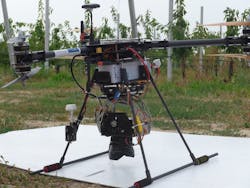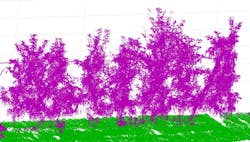
It is rare that a politician is cited in a laser magazine. But last week, Chancellor Angela Merkel spoke about digital technologies for farming at the International Green Week, here in Berlin. Referring to precision farming, she said, "this technology enables us to look at each and every plant and to enter information on specific plants, thus reducing the need for fertilizers and making forecasts possible. When artificial intelligence and its forecasting methods are added to the mix, we will be able to do absolutely wonderful things that still seem very unlikely to us today."
Does that ring a bell? In the Industry 4.0 smart-factory trend, we know that products can be customized easily. And an individual record of every tool and every workpiece is there, also known as the digital twin. In modern dairy farming, every cow has a digital twin, too. The feed consumption is recorded as well as the milk production for every individual. But this is just the beginning.
The vision that Merkel referred to is known as Precision Farming, Smart Farming, or now Farming 4.0. The common aim is a drastic reduction in fertilizer and pesticide application through clever analysis of local needs. While this has been underway for quite some time already, we may find some new examples in which optical technologies give the farmers the data they need.
What's in it for the photonics industry?
When it comes to analysis of soil or crop conditions, remote sensing from satellite based cameras for various spectral ranges has been available for more than a decade now. Hyperspectral imaging solutions have improved ever since, now also using drones or tractors as platforms. Even stationary lidar systems may help to understand local pollution or aerosol distribution.While most of the airborne systems record the radiation from the ground passively, some more-sophisticated spectroscopic solutions include illumination elements as well. One example developed by a team at the Ferdinand-Braun-Institute in Berlin, Germany, is a portable shifted-excitation Raman difference spectroscopy (SERDS) system. Tested in an apple orchard, the system was able to measure the ripeness of apples and leaves and has the potential for rapid outdoor Raman investigations even under daylight conditions. Based on the ripeness data, one can determine the perfect day for harvest. As a rule of thumb, a one-week deviation from that perfect date results in one month less storability.
The FBH system used a 120 mW dual-wavelength diode laser for excitation. A similar newly developed high-power dual-wavelength diode laser will be used next in a project named "Intelligence for soil" (I4S), in which a multidisciplinary collaboration will develop an integrated system for fertilizer recommendations and improvement of soil functions regarding nearly every square meter of soil. There, the diode radiation will be applied using a robust stabbing probe; SERDS will help to get a quantitative image of local soil constituents—useful, for example, for improving soil-nutrient management.
I4S is just one project within a larger program for "Soil as a sustainable resource for the bioeconomy" (BonaRes). The German Federal Ministeries for Education and Research (BMBF) and of Food and Agriculture (BMEL) have started several programs within the last years. Their target is a sustainable agriculture within a bioeconomy.
On the technical side, this is about a wide range of interdisciplinary collaborations: On the IT side, 5G local networks are investigated to build an internet of things in farming areas. On the optics site, we will probably see not only lidar and spectroscopy, but also machine vision and a wide range of other sensing technologies. All the data has to be processed, so artificial intelligence is required. Bringing all this to practice for a reasonable price will require sophisticated engineering. In addition to several governmental funding projects, the Fraunhofer Society has started its own initiative on "Cognitive Agriculture."While governmental funding is ramping up, the related industry is intensifying its efforts as well: For example, the AGCO Corporation (a giant in agricultural equipment) and its German subsidiary Fendt have initiated a future farm in Switzerland. After taking over Monsanto, the agrochemical giant Bayer had to sell its digital farming business to BASF. This doesn’t mean they give up on that. In the crop science business unit, they have a plan: "In the field of digital farming, we plan to develop a proprietary range of services with specific data models that simulate risk factors for crop disease outbreaks, among other things."
So it appears that Angela Merkel is promoting a trend where failure is unlikely. Data-based services will be a growing business for all smaller and larger players in the global agricultural industry. And photonics will be a substantial part of it, even under the two constraints that farmers as end users set: 1) Make it cheap, and 2) make it simple.

Andreas Thoss | Contributing Editor, Germany
Andreas Thoss is the Managing Director of THOSS Media (Berlin) and has many years of experience in photonics-related research, publishing, marketing, and public relations. He worked with John Wiley & Sons until 2010, when he founded THOSS Media. In 2012, he founded the scientific journal Advanced Optical Technologies. His university research focused on ultrashort and ultra-intense laser pulses, and he holds several patents.

